Painting Descriptions
Just my thoughts…landing on the canvas!

Monterey County Cultural Heritage
Sometimes it’s fun to create a painting for an exhibit that has a theme. I was notified of an upcoming exhibit at Seaside City Hall’s Walter Lee Avery Gallery. The exhibit was entitled “Celebrating Our Cultural Heritage.”
I got right on it. But to create a painting that would tell a story, I needed to decide…whose story would I paint.
I decided to address the cultural heritage of Monterey County, and more specifically, the cultural heritage of 4 groups of people whose history had been affected by specific events.
To do this, I created a map of Monterey County, upon which I displayed the sordid events of 3 groups who had been literally decimated and whose cultural history was lost: The Chinese/Japanese whose fishing village was burned to the ground, the Esselen Indians who were wiped out by Spanish missionaries, and the Mexican immigrant workers who were deported en masse during the Great Depression of the 1930’s and “Operation Wetbacks 1954.”
The 4th group of people whose cultural heritage was affected were the African Americans who inhabited the city of Seaside. When Fort Ord was shut down in 1994, the soldiers and their families had to relocate, ending many years during which African Americans had shared their common cultural traditions in a bustling neighborhood.
I hope this painting raises discussions about cultural heritage and the importance of histories and traditions. We must all be grateful that some descendants have survived and that some have returned to their seaside city.

Mixed Bouquet
Did you know that of the various flower bouquets that are sold, the most popular of all is the mixed bouquet? It’s a fact… and with reason. The diversity of form and color, the variety of shapes and sizes, and the combinations of many different flowers, makes the mixed bouquet the most highly desired of all flower arrangements.
That we could appreciate the value of diversity in our human forms! That we could embrace the beauty of difference and individuality in our skin tones, our facial features, and our expressions of self.
In so doing, we would become the most sought-after and popular bouquet ever. Others would appear boring, self-defeating, and obscure. It would be a wonderful world.

White Privilege
The plants tell the story. A plant from a healthy seed, raised with proper care and nurturance, will develop into a strong plant. Seeds raised with deprivation and insufficient nutrition will develop into sorrowful plants which will wither and die.
When whites sprouted, we were clutching certificates of authenticity, guaranteeing us a top spot in a competitive world. A friend of mine bemoaned the fact that there is such a concept as white privilege. “My dad and mom came from Ireland. They worked their butts off. They weren’t given any breaks. Why should it be any different for Blacks?”
My answer: Slavery is what made the difference. Whites came to the United States as free persons. They had to work hard, but they were able to build up wealth. Blacks, on the other hand, were considered the bottom rung of a deliberately designed (by Whites) caste system. Lack of nurturance and fairness has resulted in sorrowful generational outcomes.
My next painting answered his question.
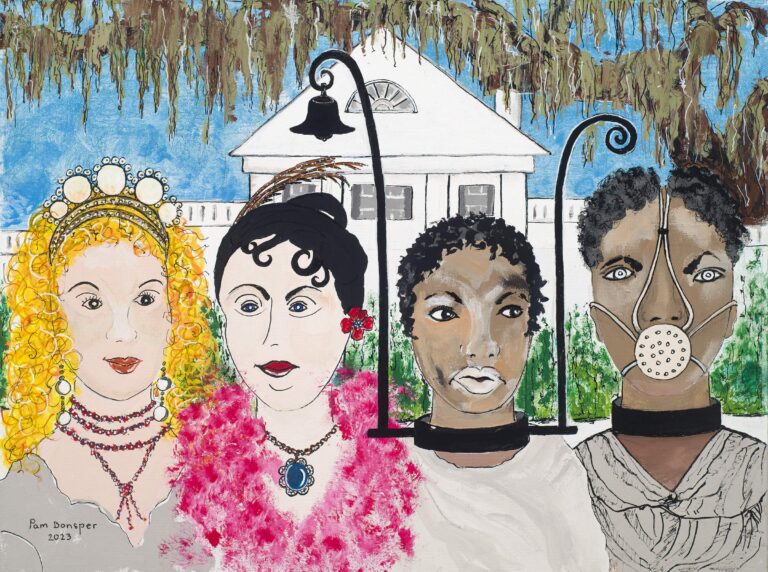
Accessories
Enslaved persons worked on plantations. They were bought and sold the same as any other possessions. Chattel is the correct word. The enslaved were chattel. The enslaved women not only worked in the fields or in the mansions from sunup to sundown, but they were often abused by their masters. It was totally lawful for their owners to rape them, to use them as breeders, to sell their children for cash or trade them for livestock.
In this painting I wanted to contrast the accessories of plantation owners’ wives to those of the enslaved. Jewelry, hair adornments, boas and spangles hung from the missus’ necks and shoulders.
The enslaved women also wore accessories: iron collars which made it impossible to escape through the woods and rivers and, though not common, headpieces (‘branks”), so they could not speak or eat.
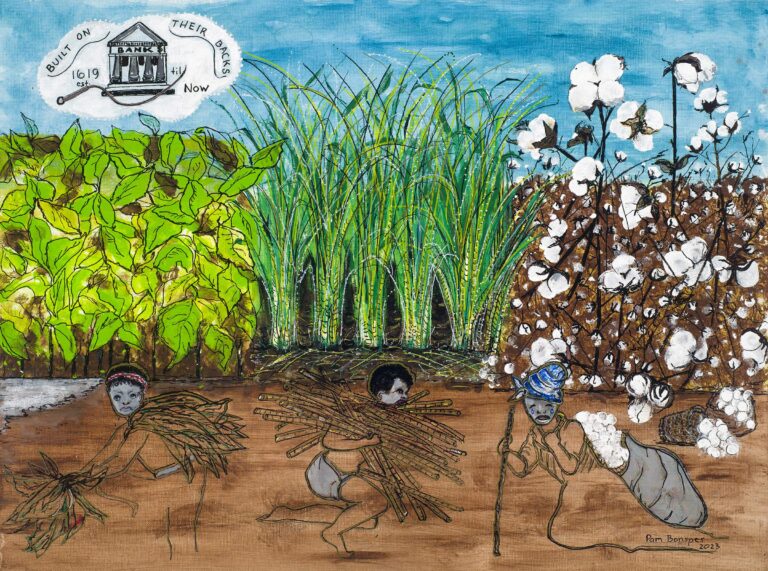
Built On Their Backs
I never put together two things: how grand and powerful our country became in so few years and how slavery was responsible for that to happen.
The fact that our nation’s success was literally built on the backs of enslaved people is just so clear to me now. I had to turn this huge fact into a painting. The paint literally spilled onto the canvas, turning into fields of tobacco, sugar cane, and cotton. The ghosts whose lives made it possible cried to me as I depicted their sad fates. That they should haunt us all is my desire. And then we must turn that remorse into action and fight for equal justice for all, reparations for those who paid the price for our national success, and restorations for their generational mistreatment and losses.

In Memorium
To pay respects and not forget the lives of so many people who were treated as animals, I decided a grand memorial was fitting. The amount of iron that was forged into collars and buckles and chains that wrapped around wrists and necks and ankles, was massive.
A person in a position of power recently remarked that the enslaved were taught skills. I don’t think making torturous devices to control whites was one of those skills.
May all enslaved persons, lost, killed, or forgotten rest in peace.

Broken Dreams
After emancipation, the formula to reach the American dream was presented to the freedmen:
Step 1: Leave the South, move to the big cities. Step 2: Find a job, no matter how backbreaking or demeaning. Step 3: Get married and start a family. Everyone, even the children worked to save money. Step 4: Buy a house.
But suddenly, the American dream was now broken. It was, instead, “For Whites Only,” as were restaurants, shops and drinking fountains.
“Redlining” was the name of this White game. City officials crafted maps, using red pens to cut up their cities, depicting “grades” according to desirability. Green was where whites resided and Red was where Blacks lived. Loans were denied to anyone who lived in the Red areas. No loans, period! Which meant no step number 4 for Blacks. They were completely forced out of the housing market.
Broken dreams, just like that. Whites moved into the Black neighborhoods and bought them out. Blacks were forced into impoverished, crowded, and unhealthy areas. And that’s how ghettoes were born.

Unity
The only solution to deep-seated hatred and national instability is for all Americans to unite. When we can truly believe that every person is of equal value, if we can work together as one, if we can hold hands in trust regardless of color, creed, or circumstance, perhaps then we will be able to become a united nation. The initials BIPOC and LBGTQ+ are to be understood and honored. BIPOC stands for Black, Indigenous and People of Color. LBGTQ+ stands for Lesbian, Bi-Sexual, Gay, Trans, Queer and others.
In this painting, blue and red colors signify our two major political parties. Purple suggests a willingness to work together. The various colors of the hands honor the beauty and importance of all complexions. The rainbow honors all LBGTQ+ people. The blue above suggests our sky and the blue below is symbolic of our planet Earth.
This painting arose from a design my son created. I loved it and turned it into a painting. It says it all. The original size is small, but it’s one of my favorite pieces.

Because We Need Each Other (with Rainbow)
My granddaughter and her best friend stood side by side looking across the ocean one day and a photo was taken by the friend’s mother. I loved the composition and setting. I thought how beautiful it would be if friends of all colors could stand side by side, arm in arm, and enjoy the power and beauty of the great Pacific Ocean.
I decided to paint the image that swirled in my head, adding the rainbow to include all children. I showed the painting to Jacqueline Simon, a fellow CAA member, and she suggested the name of the painting and asked me to do a similar one for an upcoming Forum she was leading.
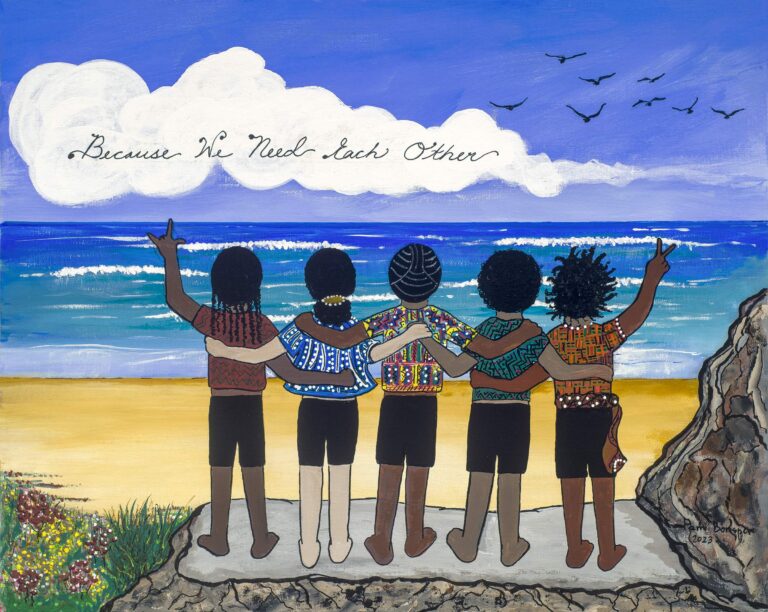
Because We Need Each Other (with Clouds)
I painted a slightly different version of my children looking across the ocean for Jacqueline’s George Floyd Forum. Jacqueline explained the significance of looking across the open sea with a bright cloud overhead. “Our history has been wrought with horrible experiences around the sea and water,” she told me. “I would like a painting in which African American children are happy looking at water, looking at the ocean. Where they are unafraid and embrace water’s beauty and feel it can be part of their life experience, too.”
From the Middle Passage when slave ships transported hundreds of thousands of men, women, and children across the Atlantic to the colonies (many of whom died and whose bones still lie on the bottom of the ocean) to the enslaved who tried to escape dogs and guns by running through rivers (many of whom were shot and whose bones lie at the bottom of the rivers) to the Draining of the Pools, during which public swimming pools were drained and shut down, disallowing Black children to learn to swim simply because Whites didn’t want Black skinned people poisoning the water…
Who wouldn’t have an issue with water?
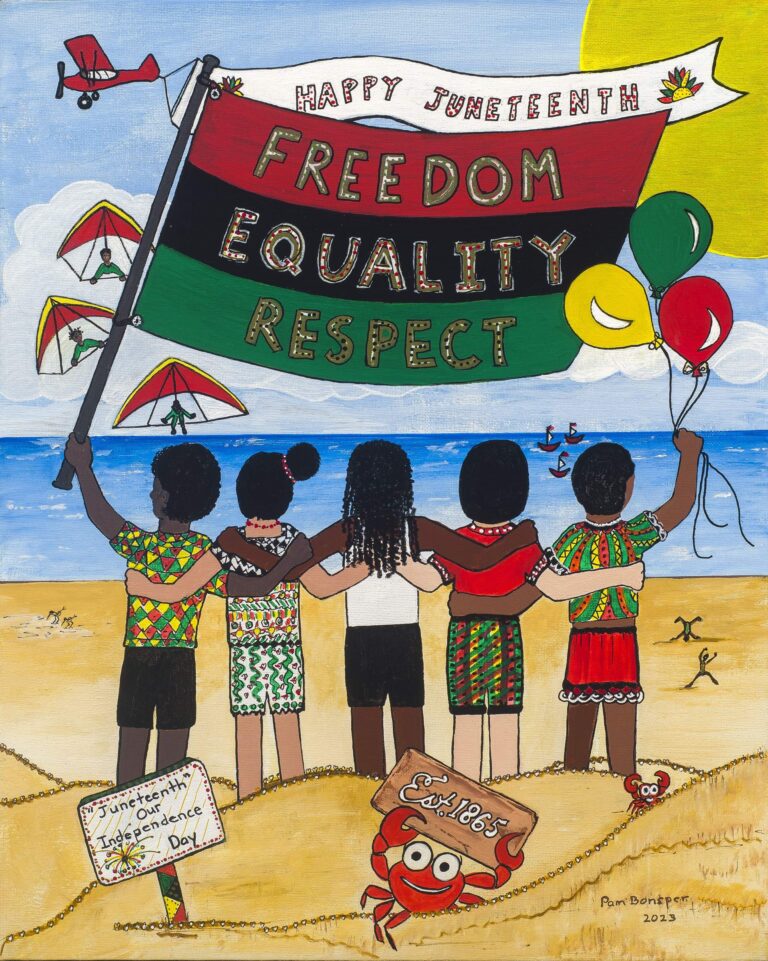
Juneteenth
Another painting with the kiddos. I just wanted to keep painting them. Juneteenth was coming up and why not have them share the facts and history of this special day?
Juneteenth is African American Independence Day, also known as Freedom Day or Emancipation Day. It’s a strange and unsettling story. After the Civil War, in 1863, the Emancipation Proclamation was passed by Abraham Lincoln freeing all enslaved persons. However, in Texas as in other southern slave states, losing free slave labor was not going to happen. Slave owners had too much to lose.
Federal intervention was necessary. Two and a half years after the Emancipation Proclamation was signed into law, US Major General Granger was ordered to go to Galveston, Texas with his troops and force implementation of the law. On June 19, 1865, enslaved persons in Texas were finally free.
The name Juneteenth is a combination of June and the 19th. African Americans have been celebrating this important date by joining together in community gatherings, festivities, singing, food, and fun. In 1979, Texas became the first state to declare Juneteenth a holiday. President Biden declared it a national holiday in 2021. Some states still do not recognize Juneteenth.
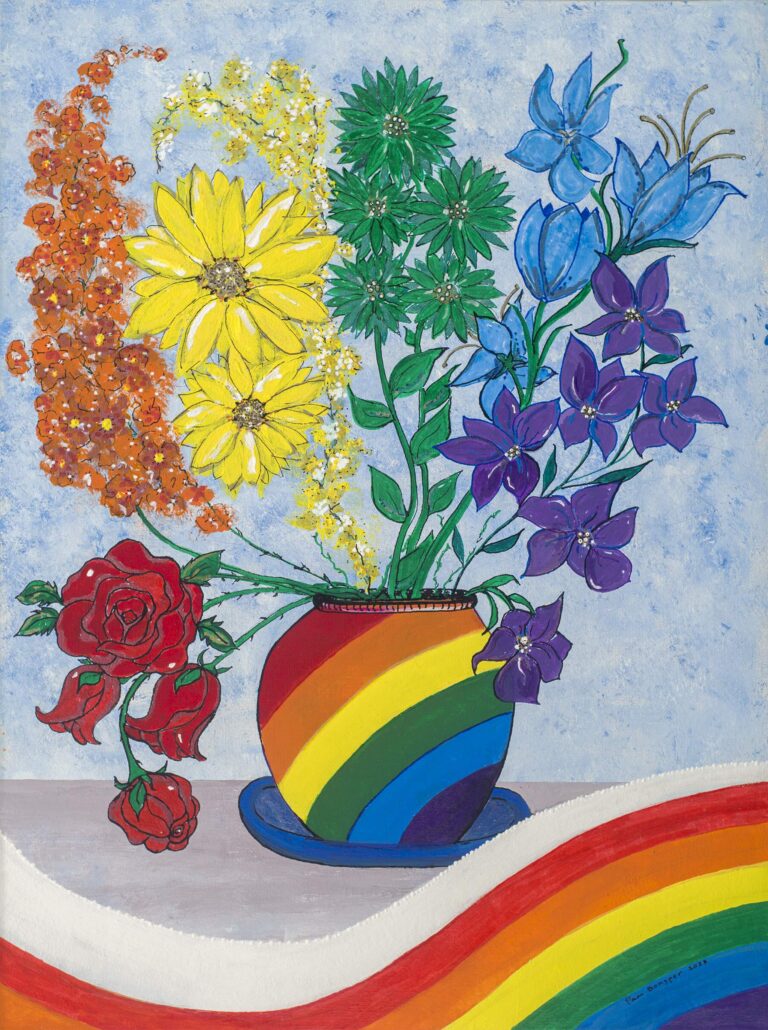
Rainbow Bouquet
To honor Pride Day Monterey, I decided to make a bouquet of flowers using the colors of the rainbow. The rainbow has long been a symbol of hope and the promise for a safe future. In 1978, the first LGBTQ+ rainbow flag, symbolizing pride and unity was unfurled at the San Francisco Gay and Lesbian Freedom Day Parade.
As with “Mixed Bouquet,” diversity, acceptance, and beauty are most easily expressed using all varieties and combinations of flowers.
If we can appreciate the uniqueness and individuality of each individual flower and experience the joy of seeing all colors and types mixed, perhaps we can enjoy all people on our planet and accept and appreciate each other for the unique and beautiful beings we are.

Javier
One of CAA’s most rewarding projects is our scholarship fund. Since our inception in 2020, we have awarded fourteen African American students thousands of dollars, enabling them to attend institutions of higher learning. One of our first recipients was Javier. He is bi-racial, multi-cultural, and gifted. I wanted to include all these aspects in his portrait. The flowers symbolize El Salvador, The United States, and Mexico. The backdrop of Africa emphasizes his African American heritage.
Thank you, Javier, for sharing your portrait with the entire world. May it encourage all teens and young adults to be who they are, to stand tall, to believe in themselves, and to reach their goals.
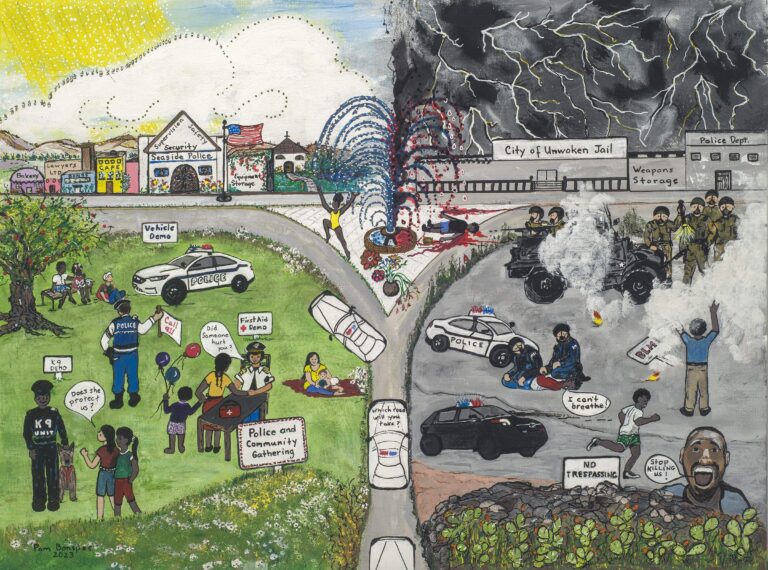
Policing: The Good and the Ugly
Police officers did not kill just George Floyd; they killed something in all of us. They killed innocence, naiveté, and trust. Complacency and complicity were no longer acceptable. The cruel realities of being Black, displayed in living color all across the world, commanded our attention.
The disgust at police officers grew as cell phones captured the truth. Passersby, emboldened by the power of a few seconds of video, recorded atrocity after atrocity. We had to believe the unjust and illegal treatment of African Americans by police officers was real.
The dilemma was quite apparent as shootings and killings continued. Two camps emerged. Those who hated the police actions and those who thought their actions were justified. Certainly, the safety of police officers is not to be denied. They are often subjected to extremely difficult and dangerous situations.
In this painting, I illustrate two approaches to policing. Although exaggerated, I hope the dichotomies are apparent. Hopefully, someday all police departments will follow the lead of our Seaside Police Department.

The Georgia-man
During the fifty years before the Civil War, Georgian slave traders came north to Virginia where they bought captured people for $300 apiece and sold them in Georgia or other southern states for twice the price. It was a lucrative business. The traders just had to move the slaves.
When the enslaved saw slave traders from Georgia moving about, looking for the strongest amongst them, they were petrified. A loathsome specter emerged.
That symbolic specter became known as “The Georgia-man.” He was the Boogie man. He was the Devil. He would force march his newly acquired possessions six hundred to one thousand miles, over mountains and through rivers. The trek lasted up to 3 months.
The Georgia-man would finally sell the survivors to owners of holding jails, or “slave pens.” The owners of these imprisonment camps hosed down the filthy survivors and fattened them up so they would glean the highest prices.
Approximately one million enslaved individuals, pregnant women, and children included made this treacherous forced march. Thousands died along the way. Named after the infamous Indigenous “Trail of Tears,” their journey is now known as “The Slavery Trail of Tears.”
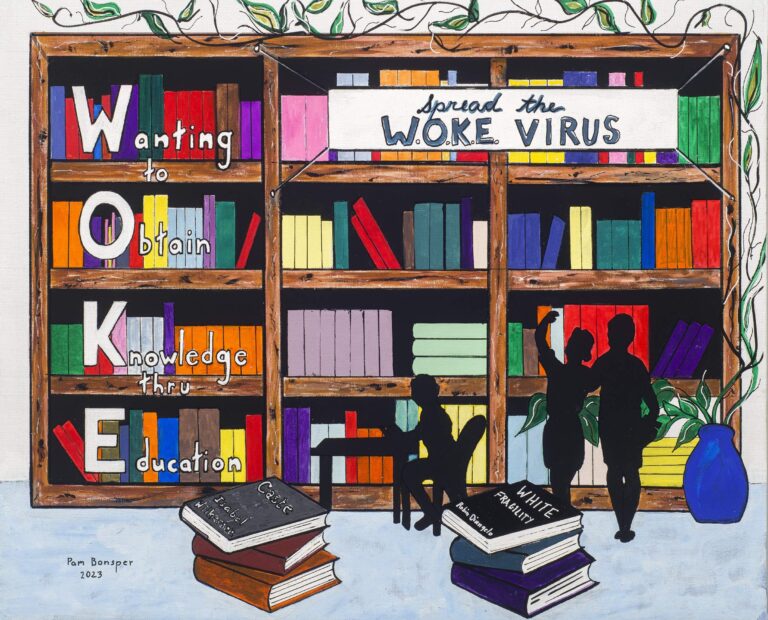
WOKE
After hearing the Governor of Florida warn his citizens to be aware of the WOKE virus (it’s everywhere!) I wanted to scream! How the word has been misinterpreted is a shame. It has been weaponized, twisted like a pretzel, and used to denote any policy, idea, and/or fact that far right conspiracists disagree with.
The truth is: The word WOKE has been used in African American communities since the 1940s. It became more popular during the Black Lives Matter movement. The meaning is what it sounds like: to be woken up or sensitized to issues of injustice.
I thought of a way to define WOKE and decided to put my definition on canvas. It is very simple:
WOKE means: Wanting to Obtain Knowledge through Education. I hope you like it. And I hope you spread the WOKE virus! Let’s hope everyone gets WOKE. It sure would be a better world.
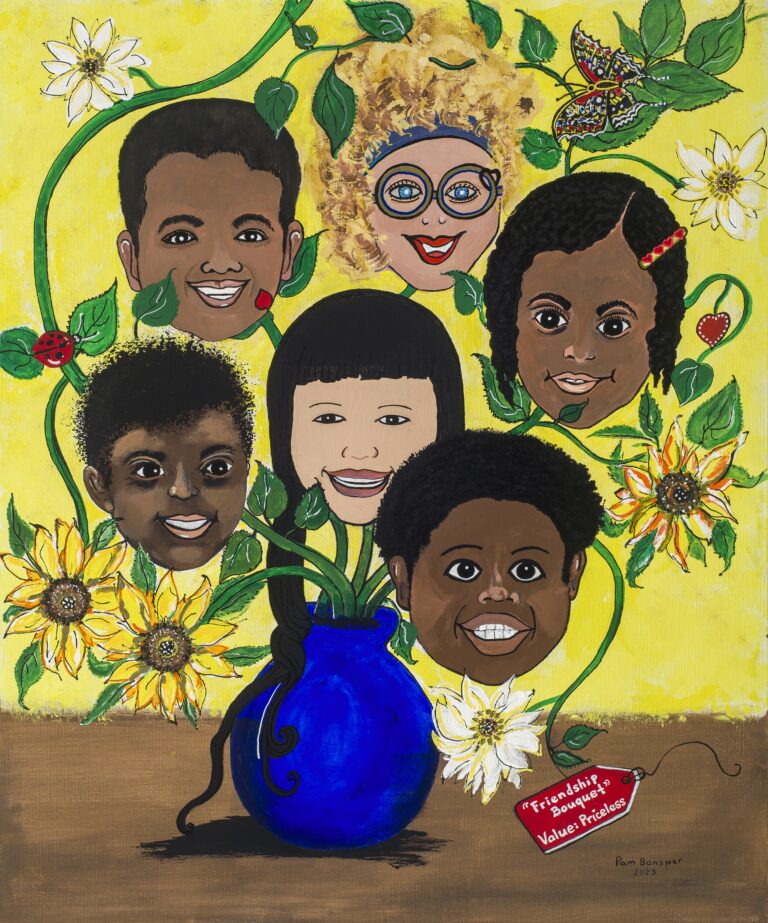
Friendship Bouquet
When my son was in kindergarten, he made a friend. We were living in Virginia. He returned from school one day bouncing with joy. “I have a best friend,” he announced. “He has a Superman shirt and shoes just like me, and he has a lunch box like me. We’re just alike!”
Exchanging phone calls, Marvin’s mom and I arranged a day when Marvin could get off the bus at our house. When the two boys scampered off the bus, I was so surprised. Marvin was as black as my son was white. Marvin’s complexion was dark chocolate and my son’s was white ice cream. When I took Marvin home, his mom and I laughed our heads off. We were so delighted with their friendship. The boys enjoyed playing together and they loved having sleepovers.
A few months later, the boys were no longer sitting together on the bus. I asked my son what was wrong. “The other kids said we shouldn’t like each other,” he said. “Then they called us names.”
He didn’t understand. But I did. It broke my heart. Racism had shattered their relationship. As I worked on this painting, I envisioned Marvin. He is the child with the biggest smile.
That’s how I remember him when he and my son looked “just alike.”
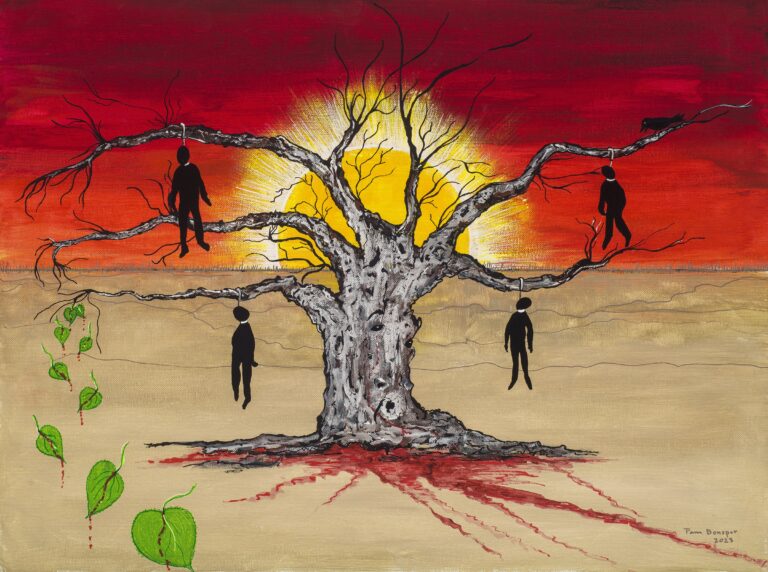
Strange Fruit
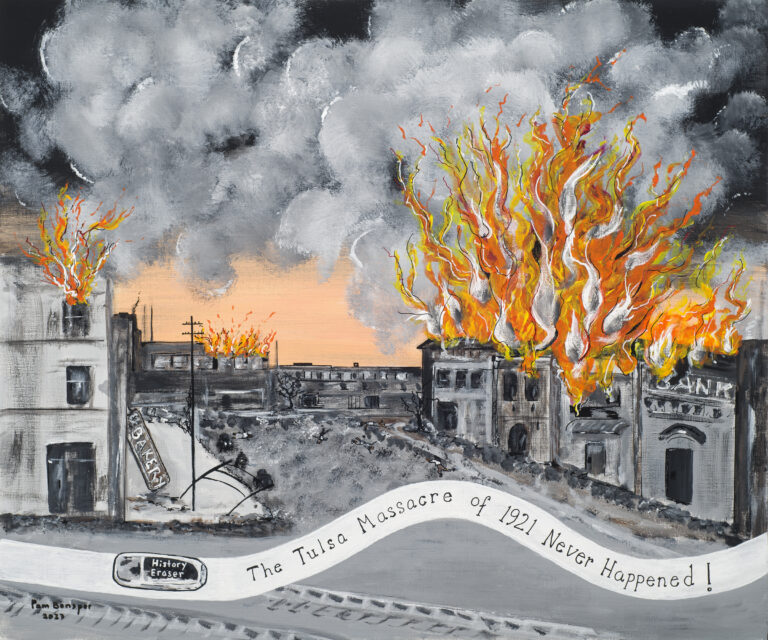
Erasure: Tulsa Massacre 1921
According to Lawrence Hall: “Black erasure is often a deliberate and malicious act to “whitewash” something for public consumption.” In other words, it is a way to erase history.
The Tulsa Massacre was the malicious and cruel destruction of the entire community of Greenwood, Texas. This thriving Tulsa area was also known as “Black Wall Street.” It was an American success story. The only problem: it was a Black success story. That the Black community was building wealth and prospering was too much. It had to be burned down. A protest by Blacks to save a young man from a lynching provided the golden opportunity.
In my rendition of the destruction, I wanted to include the practice of erasure. For many years, the Tulsa Massacre was treated as if it never happened. However, it has been included in Oklahoma history books since 2009. Unfortunately, mass graves are still being searched for.

Music Stolen, Talent Erased
Enslaved Blacks brought their music to the United States when they were kidnapped and enslaved. Being forced to work from dawn until dusk, singing was an essential panacea. The swing and sway of the blade slipped into their arms and legs, creating dance. Bodies filled with pain, their minds filled with angst, they became the music. Their songs contained coded messages allowing them to communicate. Their songs were their salvation.
Erasure of the who, how, and why of these “Negro Spirituals” was subtle. The songs became part of American culture with no acknowledgment of the suffering of their creators. Erasure has continued throughout the years. Black music has often been sabotaged and re-recorded by whites. Producers and studios have cheat musicians with unfair and devious contracts.
Black songwriters, musicians, singers, and performers have greatly enhanced our national cultural experience. We must remember to give them credit. We must not destroy the beauty nor deny the magnitude of the contributions of Black music and Black talent. These attributes will never be blown away because notes twine around Black DNA, rhythm beats within their heartstrings and music is in their very souls. It will never go away.
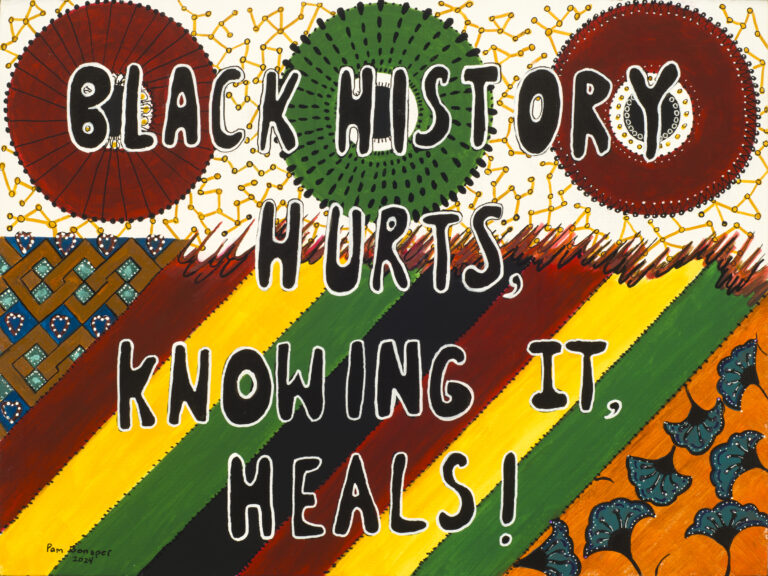
Black History Hurts
I had been sewing totes using African Prints and decided to use some of the patterns in a Black History poster. Large circles ran across the canvas, their colors deep and the reds so dark, it looked like blood. The many small gold circles which surrounded the large globes in no obvious pattern were troubling. Confusing and dangerous, they seemed to be setting traps, or at least, sowing discord. The feeling I had as I painted was telling me something. It was telling me, “Black history hurts!”
And so, where to go from there? I chose the right-hand corner and flowers appeared, a promise of something better. I reminded myself that this painting’s purpose was to depict Black History Month and so I ran the colors, red, black, and green up the center and found another piece of fabric with what appeared to be links. My mind, of course, went to the chains of bondage, the hurt returned and so I added hearts. A saying came to me: Black History Hurts, Knowing It Heals.
I truly believe that we must not fear facing the facts about Black history. Perhaps by knowing the facts, we as a nation will be healed.
It’s certainly a place to start.

Erasure in the Workplace
Being an actor in the workplace is hard work. It is demeaning and degrading. This is an example of “erasure.” Can you imagine how it would feel if the roles were reversed? If we white people had to change our mannerisms, ways of speaking, and expressing ourselves? If we weren’t listened to, treated equally, or given a chance to be who we are, what we value, what we can offer, how far we are able to go?
Of course, as in my other paintings, I have exaggerated the differences in dress and attitudes the Black players display. They would not dress like this, nor present themselves as haughty or angry or peeved by the lack of interest in who they are. They would lose their jobs! The erasure is sometimes blatant, but most often, nuanced, subtle, yet always insidious.
In my opinion, erasure of personhood is worse than rewriting history and ignoring the accomplishments of Blacks (and people of color and members of the LBGTQ+ community). Being treated as a second-class citizen and being forced to become someone other than who you are, is emotional abuse at its worst.
May we accept the fact that all humans deserve to be their authentic selves, that their talents and strengths are given equal value, and that the workplace is a better place when all of us show up…just as we are.
